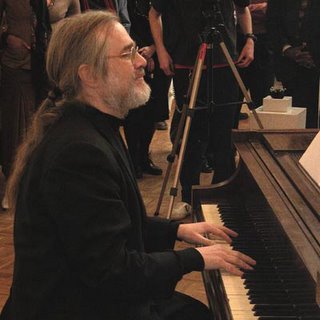 Robert Carl
Robert Carl was
in the neighborhood last week for the premiere of his saxophone quartet
Where Sound and Thought Meet, so we brought him by to talk with our students.
Iíve known Robert for about 20 years, but this was my first opportunity to spend an extended amount of time with him. Heís a wonderful conversationalist Ė witty, erudite, and down-to-earth. He played a recording for us of his
String Quartet No. 2: Fear of Death/Love for Life, which is from 2001. The piece is in three movements; the outer movements trace the juxtaposition of the title, and the inner movement serves as a connection and reflection of its partners.
The students were crowded around the only score, so I wasnít able to see it, but the piece has a very strong profile that is easy to recall. The first movement features wrenching harmonies, with twisting, overlapping glissandos that feel agonizingly like skin being slowly torn apart. The third movement begins with a rapid-fire, two-note motive that feeds a steadily developing rhythmic frenzy.
When I asked him about his harmonic language, he went over to the piano to play a recent etude for us that demonstrated some of his current interests. A supermodal melody centering around D in the inner voice functioned as a cantus firmus. Bass notes were chosen that have that D in their overtone series, while also matching up with subsidiary tones in the melody. Every slight adjustment in the melody spawned a host of new partials circling the central line. The result is a harmonic world that connects to the melody in a way that sounds both fresh and yet logical. Crossed with Carlís elegant sense of rhythm and registral interplay, the music manages to be both captivating and strangely soothing.
Robert was a great guest: gently challenging the students, answering their questions honestly, covering a wide range of topics from the sublime to the ridiculous. Be sure to keep an eye out for him if he comes to your neighborhood.



